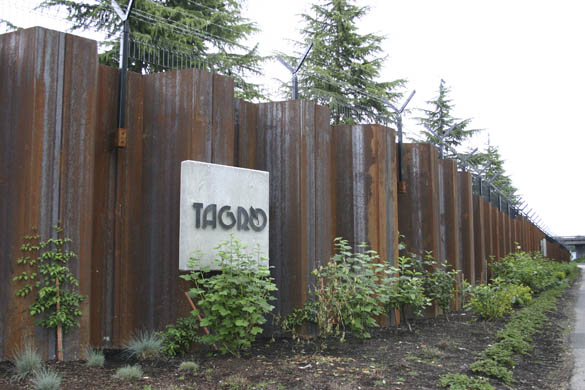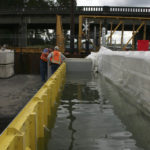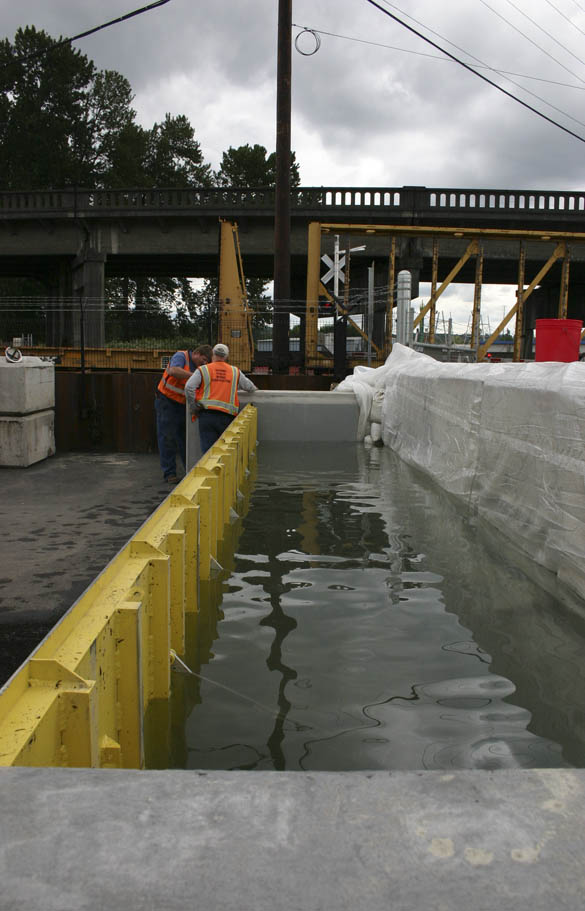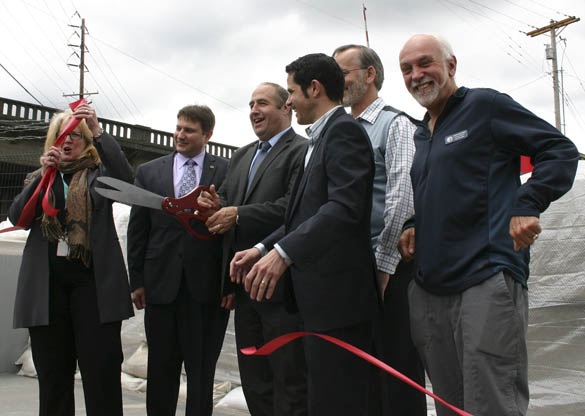The next time heavy rain falls and the Puyallup River threatens to overflow, employees at the City of Tacoma’s Central Wastewater Treatment Plant won’t be scrambling to stack sandbags. A new 2,500-foot-long, nearly $10 million wall is expected to provide protection.
One year ago this month, the City broke ground on a project to construct the imposing barrier, which is the color of old pennies and shaped into corrugated ridges and grooves that aim to bolster its rigidity. The wall ranges from one to eight feet high, and extends as deep as 25 feet into the ground.
“There’s a long story going back to 1997, which was our first major flood event where we almost lost this plant,” said City of Tacoma Environmental Services Manager Mike Slevin during a ribbon-cutting ceremony on Weds., June 3, to mark the project’s completion. “There was another time in the 2000’s when we came close—not quite as bad as the 1997 event. So it’s been almost 20 years now that we have been working on trying to find a way to protect this very critical and crucial asset.”
According to Slevin and other City officials, a major flooding event would potentially destroy equipment at the plant and cause millions of gallons of untreated wastewater from Tacoma, Fircrest, Fife, and unincorporated Pierce County to overflow into Commencement Bay and Puget Sound.
Visitors to the plant can pass through the new wall via six access points: three hydrostatic lift gates are designed to activate automatically in the event of a major storm or flood, while the other gates would be closed manually. The project was paid for using approximately $3 million in utility customer rates, as well as approximately $6 million in Pierce County Flood Control Zone District funds. The project was designed by CH2M Hill and City staff. The contractor was IMCO General Construction. According to City staff, the project was completed within budget and two months ahead of schedule.
“Almost seven years ago, when I first became county executive, the third day on the job my department of emergency management director came in and said, ‘You need to sign a declaration of emergency for Pierce County,'” recalled Pierce County Executive Pat McCarthy. “We went out along with the secretary of the Washington State Department of Transportation and others to stand on the edge of the Puyallup River and [it was] looking that it very well may go over. The devastation that would be, not just to that place where we were located, more in the Puyallup area, but really all of the upriver and downriver—and what that devastation would have potentially been here for the treatment center.”
One of the biggest project challenges was to build a section of the wall around a 48-inch water main that serves many industries in the area. “The water main is extremely important to a lot of the industries in the tide flats,” said Slevin. “Keeping that line in service while all of this took place—you can imagine how deep some of these piles are. Pounding around that pipe and protecting that pipe was really crucial . . . I was not sleeping very well the three or four days that they were working around that water main. When I got the call that they were done and it was through, I was very happy.”
Tacoma’s Central Wastewater Treatment Plant, which is situated adjacent to the Puyallup River, was built in 1952, expanded in 1979, and underwent significant upgrades in 1988 and 2009.
During the ribbon-cutting ceremony last week, workers activated one of the hydrostatic lift gates to demonstrate how water would be collected and diverted in order to protect the plant. Officials also displayed mobile pumps that will help keep water out of the facility.
Following the demonstration, City of Tacoma Environmental Services Assistant Division Manager Eric Johnson walked a significant length of the southern floodwall along Cleveland Way with the Tacoma Daily Index and described the project in detail.
TACOMA DAILY INDEX: Can you describe the project and how this floodwall would work in the event of a flood emergency?
ERIC JOHNSON: The height of the floodwall has been designed for a statistical one-in-500-year flood event. In reality, we added one more foot of height for a safety factor. The thought process is that during [a large storm event] the area most susceptible along the Puyallup River is upstream from here. The U.S. Army Corps of Engineers dike system gets overtopped, the water overflows, and then naturally, as far as elevations, where it comes in is down here. It goes down the Burlington Northern rail yard and then slanted to the north and discharged into one of the other waterways. The lowest elevation is right here out in the BNSF rail yard. This is where the water is going to stack up.
INDEX: So then if the Puyallup River breaches the dike, the gate system kicks in, correct?
JOHNSON: Yes. There are six openings within the wall to allow people and cars to come in and out. Three of the gate openings [in this section] are automatic because this is the lowest elevation and the first spot that would flood. When that happens, now it’s time to go put the manual gates in place. That was the thought process. The automatic gates are obviously way more expensive than the manual gates, but they are foolproof, right? There’s no human error factor in there.
INDEX: What happened to the water that was collected during the automatic gate demonstration?
JOHNSON: It drains to the stormwater system. All the pouring rains that happen during a big event inside the plant have got to go someplace. So [the system] will pump it from the inside of the plant out to the other side of the wall where all the other flood waters are. That part of it is a little complicated because there’s a whole network of stormwater pipes beneath the plant that collect stormwater from all over the tide flats.
One of the risks is the catch basins on the plant side of the wall are all tied in together. If you have a big flood, the floodwall is in place and you have five feet of water over here and the wall is keeping the water out from over there, which is great. But then there is five feet of water on top of the catch basin, so it’s just going to push all the water down through and come up through the catch basins on the other side of the wall. So you are actually going to be conveying the flood waters from over here via your pipe network down and up to the other side of the plant and the wall. So there were about eight locations where those cross connections happen and we have installed valves. So when this flood happens, those valves will get shut and you would isolate that. You wouldn’t allow it to go in.
And then what the pumps are for is—we basically no longer have a surface water collection system for inside the plant—so all the rain that falls has to go somewhere. Those pumps allow us to pump all that out.
INDEX: Earlier today, several people mentioned recent emergency storm events here at the plant. What do you recall about those events?
JOHNSON: There was a big concern that an overtopping of the Puyallup River levee was going to happen. We knew where the water was going to come because it had happened in the 1990s. We mobilized staff to start filling sandbags. You start realizing how futile it is.
First of all, you’ve taken all your resources at the plant that really should be looking into emergency operations. Instead, they are filling sandbags. If the water really came, were we going to be able to sandbag it? We wouldn’t. In fact, we didn’t sandbag like this [floodwall] alignment. We went to internal places within the plant. Stuff below ground here. There are tunnels full of sensitive electrical instrumentation equipment and everything. So what we were doing was sandbagging the entrances to those. They wouldn’t seal that well. You would still have a big problem.
That’s what was going on—scrambling of sandbags and getting the materials here to sandbag and getting personnel here in the middle of the night to sandbag. We had engineers and office people come in and fill sandbags.
INDEX: In an emergency storm event situation now, would you just sit back and let the system—the gates, floodwall, and pumps—do its thing?
JOHNSON: Yeah, basically. Well, you’ve got to put the manual gates up, mobilize the pumps, monitor things. The plant would be protected so that you can have your staff out doing all the other stuff that they really need to be doing. There are 700 miles of underground wastewater pipes in the city that collect and convey the water to this location—and the North End treatment plant location—but this plant takes 80 per cent of the flow. So there’s flooding happening out there and crews are working on that stuff, which is where they need to be. There’s 48 pump stations out in the 700-mile network of pipes, too. So crews need to be out there dealing with that. That’s the hope—that you would sit back and let the system do its thing and provide the protection.


To read the Tacoma Daily Index‘s complete and comprehensive coverage of the Central Wastewater Treatment Plant flood protection project, click on the following links:
- Tacoma completes $9M floodwall project at wastewater treatment plant (Tacoma Daily Index, May 8, 2015)
- City of Tacoma: $9M floodwall project on schedule, within budget (Tacoma Daily Index, March 30, 2015)
- Tacoma City Council OKs $6M flood protection project (Tacoma Daily Index, April 2, 2014)
- City Hall News: $300K strategic plan contract, bike/pedestrian safety improvements, and BIA renewal/expansion (Tacoma Daily Index, March 28, 2014)
- 7 contractors bid on Central Wastewater Treatment Plant flood protection project (Tacoma Daily Index, March 26, 2014)
- Tacoma seeks bids for Central Wastewater Treatment Plant flood protection project (Tacoma Daily Index, Feb. 18, 2014)
- Tacoma awarded $6M for wastewater treatment plant floodwall (Tacoma Daily Index, October 15, 2013)
- Central Wastewater Treatment Plant upgrade and expansion update focus of study session (Tacoma Daily Index, May 7, 2007)
- Tacoma’s wastewater treatment wins national honors (Tacoma Daily Index, April 7, 2004)
Todd Matthews is editor of the Tacoma Daily Index, an award-winning journalist, and author of A Reporter At Large and Wah Mee. His journalism is collected online at wahmee.com.














